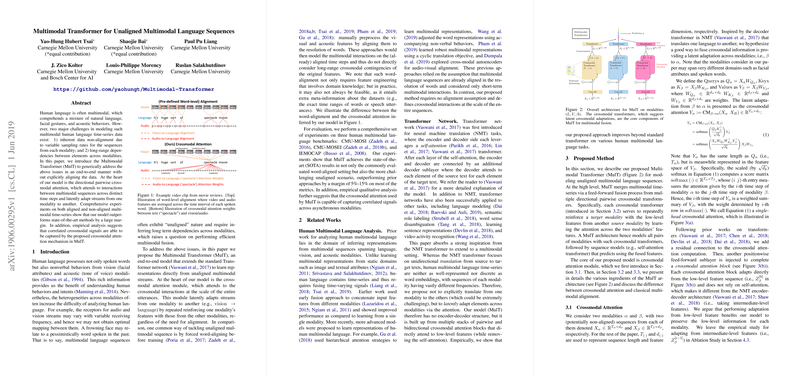Multimodal Transformer for Unaligned Multimodal Language Sequences: An Overview
The paper "Multimodal Transformer for Unaligned Multimodal Language Sequences" by Yao-Hung Hubert Tsai et al. addresses two primary challenges in modeling multimodal human language: data non-alignment due to varying sampling rates and long-range dependencies between modalities. These aspects are crucial for handling real-world multimodal data effectively. The proposed Multimodal Transformer (MulT) leverages a novel approach to address these issues without requiring explicit alignment of the data sequences.
Introduction
Inherent diversity in data modalities (e.g., language, vision, and audio) introduces significant challenges in synchronizing and understanding multimodal interactions. Previous approaches have typically relied on manual alignment of multimodal sequences to a common resolution, often based on word segments. This manual process not only requires domain-specific feature engineering but also limits the ability to capture long-range crossmodal dependencies.
To mitigate these limitations, Tsai et al. propose MulT, an end-to-end model that extends the Transformer architecture to the multimodal setting using crossmodal attention. This method does not necessitate pre-alignment of sequences, instead focusing on attending to interactions between sequences across different modalities.
Model Architecture
The core innovation in MulT is the crossmodal attention mechanism, which attends to signals between different modalities and adapts streams from one modality to another. Specifically, MulT comprises several key components:
- Crossmodal Attention: This module is designed to learn attention scores between sequences from two different modalities, capturing interdependencies directly. It allows latent adaptation of features from one modality to another.
- Temporal Convolutions: Applied to each modality to ensure local temporal context, these convolutions also help project features from different modalities to a common dimension, facilitating the attention mechanism.
- Positional Embeddings: Leveraging sinusoidal positional encoding, the model captures temporal order information, a critical aspect often lost in attention mechanisms.
- Crossmodal Transformers: Each crossmodal transformer links a pair of modalities, stacking several crossmodal attention blocks to recursively integrate information from the source modality to the target modality.
The model processes multimodal sequences by adapting features within each modality at multiple scales of granularity. It ultimately concatenates the outputs from all crossmodal transformers and employs self-attention transformers and fully-connected layers for sequence modeling and prediction.
Experimental Evaluation
The experimental evaluation of MulT is conducted on three pivotal datasets: CMU-MOSI, CMU-MOSEI, and IEMOCAP. These datasets are widely used for benchmarking multimodal sentiment and emotion analysis. The evaluation includes both word-aligned and unaligned versions of the datasets.
Word-Aligned Experiments
In the word-aligned setting, MulT demonstrates superior performance over several state-of-the-art methods, achieving significant gains across various metrics:
- CMU-MOSI: MulT improves the 7-class accuracy (Acc) to 40.0 and binary accuracy (Acc) to 83.0, notably surpassing previous models by margins ranging from 5% to 15%.
- CMU-MOSEI: MulT achieves Acc of 51.8 and Acc of 82.5, highlighting its effectiveness even with larger and more complex data.
- IEMOCAP: MulT delivers strong performance across different emotion categories, particularly excelling in recognizing 'happy' instances with an F1 score of 88.6.
Unaligned Experiments
For unaligned sequences, the results are particularly notable as MulT continues to outperform earlier methods that rely on alignment strategies:
- CMU-MOSI: Without alignment, Acc is achieved at 81.1 with a correlation of 0.686.
- CMU-MOSEI: MulT maintains robustness with Acc of 50.7 and Acc of 81.6.
- IEMOCAP: MulT shows resilient performance, particularly in recognizing the 'neutral' and 'happy' classes despite the unaligned nature of the sequences.
Implications
The strong performance of MulT in both aligned and unaligned settings underscores its flexibility and robustness. The crossmodal attention mechanism enables a more fluid and dynamic interaction between modalities, capturing long-range dependencies that traditional alignment methods might miss. This capacity is crucial for real-world applications where manual alignment of data sequences is impractical or infeasible.
Future Directions
The success of MulT in handling unaligned multimodal data suggests several avenues for future research:
- Extending to More Modalities: Future work could explore integrating additional modalities, such as physiological signals, to capture richer multimodal interactions.
- Scaling Up: Investigating the scalability of MulT on even larger and more varied datasets to ensure the model's robustness across diverse applications.
- Application to Diverse Tasks: Applying MulT to other complex multimodal tasks, such as Visual Question Answering or multimodal dialogue systems, to further validate its efficacy.
Conclusion
The Multimodal Transformer (MulT) proposed by Tsai et al. presents a significant advancement in multimodal learning, particularly in effectively modeling unaligned multimodal sequences through crossmodal attention mechanisms. The empirical results validate its superiority over previous methods, and its flexible, end-to-end architecture holds great promise for various multimodal applications. Future research can build on this foundation to explore wider applications and further optimize the model's performance.
